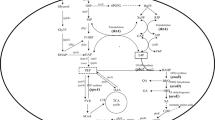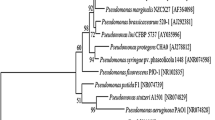Abstract
ZJ0273 (propyl 4-(2-(4, 6-demethoxy pyrimidin-2-yloxy) benzylamino) benzoate) is a novel pyrimidynyloxybenzoic-based herbicide developed in China for oilseed crop. This study was aimed to construct new strains capable of degrading naphthalene and ZJ0273 by protoplast fusion between Amycolatopsis sp. M3-1 and Pseudomonas sp. Nai8. Eight recombinant strains were successfully produced, and the strains could simultaneously utilize ZJ0273 and naphthalene as the sole carbon and energy source, respectively. One of recombinant strains, MN6 with higher degrading efficiency, was chosen for further study. Under the condition of pH 7.0, 30 °C, ZJ0273 and naphthalene degradation percent by the recombinant strain MN6 could reach 65.10 % (20 days) and 88.46 % (48 h), respectively. According to the identified six metabolites (M1–M6) by LC–MS/MS, biodegradation pathway of ZJ0273 was proposed. ZJ0273 biodegradation catalyzed by the recombinant strain MN6 involved continuous biocatalytic reactions such as de-estering, hydrolysis, acylation, C-N cleavage, de-methyl, and ether cleavage reactions.





Similar content being viewed by others
References
Cai Z, Chen Q, Wang H, He Y, Wang W, Zhao X, Ye Q (2012a) Degradation of the novel herbicide ZJ0273 by Amycolatopsis sp. M3-1 isolated from soil. Appl Microbiol Biotechnol 96(5):1371–1379
Cai Z, Xu X, Chen Q, Zhao X, Wang H, Huang L, Ye Q (2012b) Degradation charateristics and applications of Amycolatopsis sp. M3-1 for ZJ0273. J Chem Eng Chinese U 26(1):93–98
Cai Z, Wang H, Shi S, Wang W, Chen Q, Zhao X, Ye Q (2013) Aerobic biodegradation kinetics and pathway of the novel herbicide ZJ0273 in soils. Eur J Soil Sci 64:37–46
Cai Z, Shi S, Li S, Zhang W, Cai J, Yang G, Zhu X (2014) Isolation and characterization of Pseudomonas sp. Nai8 capable of naphthalene degradation. Asian J Chem 26(1):164–168
Chaurasia AK, Adhya TK, Apte SK (2013) Engineering bacteria for bioremediation of persistent organochlorine pesticide lindane (γ-hexachlorocyclohexane). Bioresource Technol 149:439–445
Cheng SP, Chen L, Yan J (2002) Degradation of purified terephthalic acid and expression of mnp gene for GEM Fhhh. J Environ Sci 22(1):1–5
Han AL, Ye QF, Wang HY, Wang W, Lu L (2009a) Absorption, translocation, and residue of 14C-ZJ0273 in oilseed rape. J Agr Food Chem 57:4395–4402
Han AL, Yue L, Li Z, Wang HY, Ye QF, Lu L, Gan J (2009b) Plant availability and phytotoxicity of soil bound residues of herbicide ZJ0273, a novel acetolactate synthase potential inhibitor. Chemosphere 77:955–961
Heim DR, Skomp JR, Tschabold EE, Larrinua IM (1990) Isoxaben inhibits the synthesis of acid insoluble cell wall materials in Arabidopsis thaliana. Plant Physiol 93:695–700
Li M, Yi P, Liu Q, Pan Y, Qian G (2013) Biodegradation of benzoate by protoplast fusant via intergeneric protoplast fusion between Pseudomonas putida and Bacillus subtili. Int Biodeter Biodegr 85:577–582
Lin C, Gan L, Chen Z (2010) Biodegradation of naphthalene by strain Bacillus fusiformis (BFN). J Hazard Mater 182:771–777
Liu F, Zhang F, Jin ZL, He Y, Fang H, Ye QF, Zhou WJ (2008) Determination of acetolactate synthase activity and protein content of oilseed rape (Brassica napus L.) leaves using visible/near-infrared spectroscopy. Anal Chim Acta 629:56–65
Lu L, Chen J, Wu J, Ling W, Mao LS, Li MZ (2004) 2-pyrimidinyloxy-N-aryl-benzylamine derivatives, their processes and uses. U.S. patent 6800590 B2
Lu J, Dang Z, Lu G, Yang C, Yi X, Guo C (2012) Biodegradation kinetics of phenanthrene by a fusant strain. Curr Microbiol 65:225–230
Paul D, Chauhan A, Pandey G, Jain Rakesh K (2004) Degradation of p-hydroxybenzoate via protocatechuate in Arthrobacter protophormiae RKJ100 and Burkholderia cepacia RKJ200. Curr Sci India 87:1263–1268
Rivas FJ (2006) Polycyclic aromatic hydrocarbons sorbed on soils: a short review of chemical oxidation based treatments. J Hazard Mater 38:234–251
Sabba RP, Vaughn KC (1999) Herbicides that inhibit cellulose biosynthesis. Weed Sci 47:757–763
Seetharam C, Soundarajan S, Udas AC, Rao AS, Apte SK (2009) Lyophilized, non-viable, recombinant E. coli cells for cadmium bioprecipitation and recovery. Proc Biochem 44:246–250
Semple KT, Doick KJ, Wick LY, Harms H (2007) Microbial interactions with organic contaminants in soil: definitions, processes and measurement. Environ Pollut 150:166–176
Tang QH, Chen J, Lu L (2005) An innovative research for novel rape herbicide ZJ0273. Chin J Pestic 44:496–502
Wang HY, Ye QF, Yue L, Han AL, Yu ZY, Wang W, Yang ZM, Lu L (2009) Fate characterization of a novel herbicide ZJ0273 in aerobic soils using multi-position 14C labeling. Sci Total Environ 407:4134–4139
Wang HY, Yu ZY, Yue L, Han AL, Zhang YF, Li JY, Ye QF, Yang ZM, Lu L (2010) Transformation of 14C-pyrimidynyloxybenzoic herbicide ZJ0273 in aerobic soils. Sci Total Environ 408:2239–2244
Yang ZM, Ye QF, Lu L (2008) Synthesis of herbicidal ZJ0273 labeled with tritium and carbon-14. J Labeled Compd Radiopharm 51:182–186
Yang GH, He YC, Cai ZQ, Zhao XY, Wang LQ, Wang L (2011) Isolation and characterization of Pseudomonas putida WLY for reactive brilliant red x-3b decolorization. Afr J Biotechnol 10(51):10456–10464
Acknowledgments
The authors gratefully acknowledge the financial support from the “National Natural Science Foundation of China” (Project no. 11275033) and “Natural Science Foundation of Jiangsu Province, China” (Project no. BK20151185).
Author information
Authors and Affiliations
Corresponding author
Ethics declarations
Conflict of interest
The authors declare that they have no competing interests.
Additional information
Responsible editor: Robert Duran
Rights and permissions
About this article
Cite this article
Chen, X., Cai, Z. A fusant of Amycolatopsis sp. M3-1 and Pseudomonas sp. Nai8 with high capacity of degrading novel pyrimidynyloxybenzoic herbicide ZJ0273 and naphthalene. Environ Sci Pollut Res 23, 3517–3524 (2016). https://doi.org/10.1007/s11356-015-5600-6
Received:
Accepted:
Published:
Issue Date:
DOI: https://doi.org/10.1007/s11356-015-5600-6




